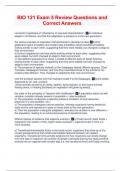BIO 121 Exam 5 Review Questions and
Correct Answers
Lamarck's hypothesis of "inheritance of acquired characteristics". ✅an individual
adapts in its lifetime, and that this adaptation is passed on to the next generation.
the various example of inspiration that led Darwin to develop his idea ✅Extinct
glyptodons (giant armadillo) and modern-day armadillos (seven-banded armadillos)
looking similar to each other, suggesting that they were related, but changed to adapt to
their environment.
b) Extinct megatherium and tree sloths looking similar to each other, suggesting they
were related, but both changed to adapt to their environment.
c) Two different populations of rheas. Located at different parts of South America,
looking similar to each other, suggesting that they were related, but both changed to
adapt to their environment.
d) The presence of species endemic to the Galapagos Islands (Marine Iguanas, Giant
Tortoises, Galapagos Finches), and how they resembled those of the mainland, but
looked a little different. They changed to adapted to their new environment.
how the ancestor species from the mainland made it to the Galapagos. ✅Some seeds
dispersed by air, sea, and bird
Some animals arrived by air (birds, spiders, flying insects), or sea (some animals
floating alone, or floating [tortoises] on vegetation raft [green iguanas]).
the order of the principles of "descent with modification" ✅A population starts out with
variation (variation already present in population + new mutations)
b) The population undergoes a selective pressure (limitation of food resources,
presence of a new predator, etc.)
c) The population undergoes natural selection, whereby organisms having beneficial
traits survive and reproduce to pass on those traits to the next generation.
d) Then the population undergoes adaptation, whereby the variation is now different in
the population, leading to an enhanced presence of beneficial traits.
different pieces of evidence that supports evolution. ✅a) Fossil record: lower strata =
organisms from earlier in time, higher strata (surface) = organisms later in time (i.e.
more recently).
b) Transitional/Intermediate forms in the fossil record: organisms that show up at the
correct geological time that exhibit intermediate features between two related
organisms. Transitional forms provide evidence for how organisms can slowly change
from one type of organism into another (Example a tetropod [having four legs] overtime
evolves into an organism with smaller legs [i.e. the transitional form] until finally evolving
, into a snake that lacks limbs. Example 2: a mammalian tetropod evolving into a form
with shorted limbs which then evolves into a whale)
c) Biogeography: helps us understand how changes in land impacts evolution. (Ex.
Squirrels of the Grand Canyon, and Marsupial mammals of Australia, vs. Placental
mammals of the other continents due to separation of the continents).
d) Convergent evolution: idea that two different species (that look different from each
other and are distantly related) can evolve to look like each other because that form is
perfect for its survival. (sharks, ichthyosaurs, and dolphins are example, euphorbs and
cacti are examples [desert plants that look like each other, but are not directly related],
ocelots and fossas are examples, raccoon dog and raccoon are examples, or sugar
gliders, flying squirrels and flying lemurs).
e) Artificial selection/Selective breeding: is a form of selection whereby humans cross
plants or animals together to select for certain traits (not survival of fittest, but survival of
desired traits). (Examples of this are... any breed of cattle, pigs, domestic cats, dogs,
horses, goats, bunny rabbits, lab mice, etc. many fruits, vegetables, and grain)
f) Experimental selection/Direct observation: in the laboratory, orga
anatomical homology ✅when different species are related because they share a
common anatomical feature or homologous structure (Example: 1+2+ many
arrangement of limbs suggest that all tetrapods evolved from common ancestor with
limbs, or pharyngeal pouches in embryos, etc.)
molecular homology ✅when different species are related because they share a
common set of genes. (Example: Pax6 [an eye development gene] is shared between
flies, mice and people [suggest common ancestor had eye genes, and passed these on
to all organisms with eyes]. Thousands of other examples as well. Such as the Shh
[Sonic hedgehog] gene which is expressed in all developing tetropod limbs, thus
allowing for chickens to grow legs and wings, frogs to grow legs, and people to grow
arms and legs).
Taxonomy ✅The scientific study of how living things are classified
organisms are organized into a hierarchy of categories (taxons or taxonomic groups):
Domain, kingdom, phylum, etc.
order of hierarchy ✅Top to bottom: Domain, Kingdom, Phylum, Class, Order, Family,
Genus, Species
3 Domains ✅Bacteria, Archaea (both prokaryotes), Eukarya (all other animals, plants,
fungi, and single cell protists)




